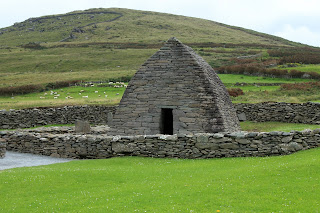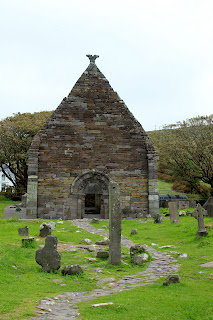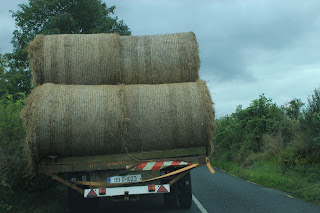Before heading into the larger towns of Galway and Dublin, we spent a few days on Ireland's west coast, driving the Ring of Kerry and Dingle Peninsula. We picked Kenmare as our gateway town rather than Kilkenny, mainly because Kenmare is smaller, quainter, and sounded like our kind of town. After our relaxing drive into Kenmare, we got checked into our B&B, Abbey Court, and quickly headed into town before all the businesses closed up for the evening. Kenmare has a small lace museum over it's Tourist Information office, several Irish goods stores, and the town has their very own stone circle, located only a five minute walk past the main drag. Awesome!

The grounds were so well kept that it basically looked like a really cool rock garden, complete with a funky, offering type tree with lots of hair ties around it's branches. Fifteen stones ring a boulder thought to be a burial monument, and of course, it's aligned with the sun. There are over 100 stone circles located just in this southwestern area of Ireland, and most date back to sometime from 500-2000 BC. You'll see in the photo that there are no other tourists walking around. We found this to be the case everywhere (except at the Cliffs of Moher, and you'll hear plenty about THAT), despite the fact that August is the highest tourist month. Despite full hotels, restaurants, and shops, and the fact that we were on a fairly popular and common tourist track, we found that we really could have sites to ourselves, wandering around, taking photos to my heart's delight. Just one more thing to love about Ireland.

We wandered around town a bit, chatted with shopkeepers, ate another great meal, and following the recommendation of our B&B owner, headed over to Coachman's Pub to hear Michael O'Brien play. Absolutely the best music experience of our entire trip. He and his fellow musicians on stage with him that night (singer, Catryn (sp?) and a banjo player, name unknown) were fantastic. So much so that we stayed from start to finish...at 1am! And this was the night before the one day of our trip that we absolutely had to get an early start (to avoid the tour buses on the Ring of Kerry) - that's a testament to how good the music was. You know how sometimes you have a fun time, and later, you remember that you had fun, but can't really recall the actual sights, sounds, feels. This moment, for me, was one of those recall moments where I can close my eyes, think of sitting in the Coachman's, and I can feel everything again - I see the low light and the musicians doing what they were born to do, I taste the Bulmer's cider that I sipped all night, I hear the music again, I feel the excitement in the air from the other people in the room enjoying the moment as much as we were. It's one of the few moments of this trip that I can so clearly remember, and what a good memory it is.
[Edit: As it turns out, we weren't listening to Michael O'Brien after all. He's probably a great musician, but we wouldn't know. Now we have another reason to return to Kenmare! Thank you, Siobhan, from Coachmans Townhouse, for the below comment and correction. Musicians were Sean O'Connor, Sean Murphy, and Cathernine, Teahan.]


















































